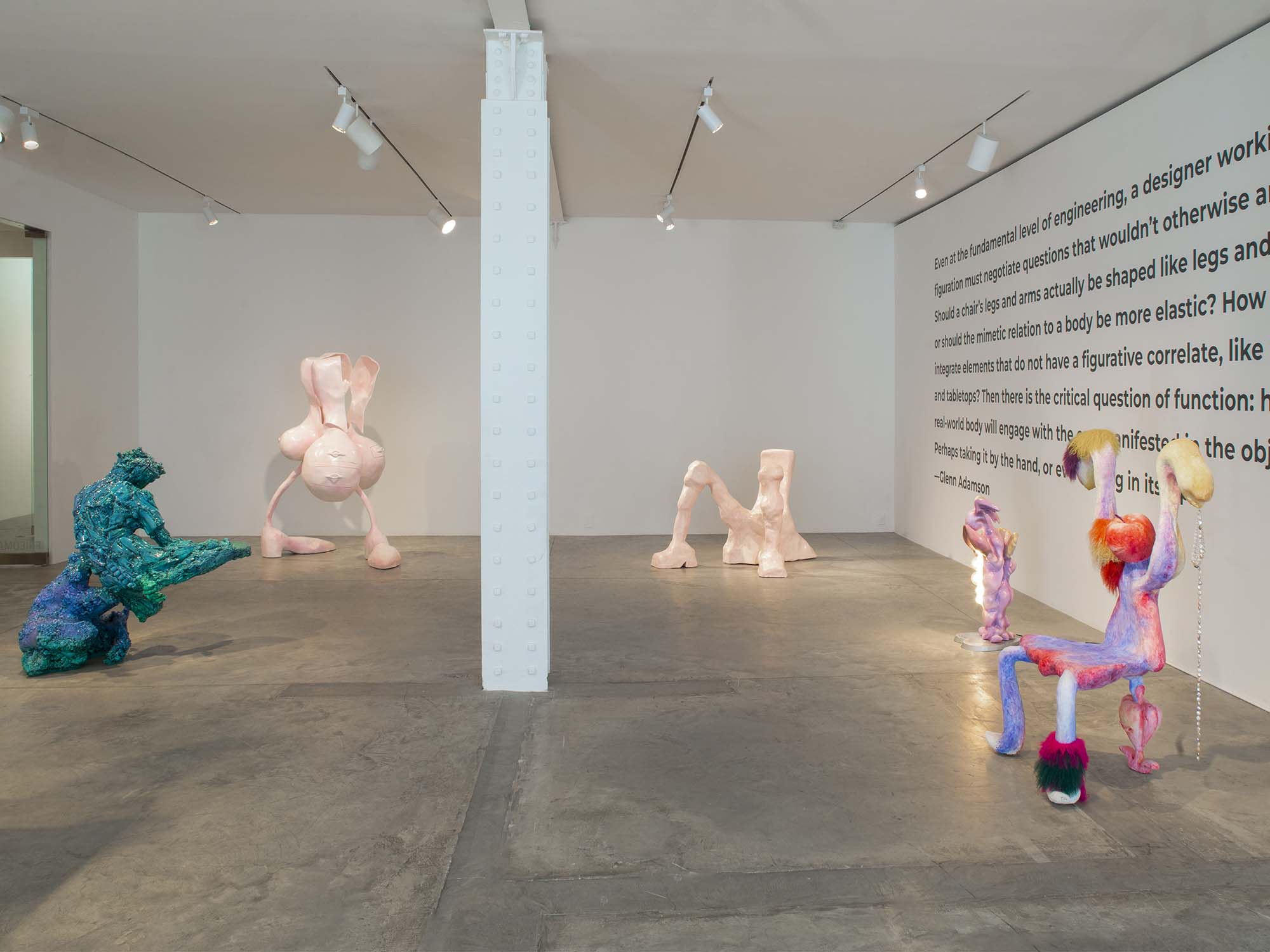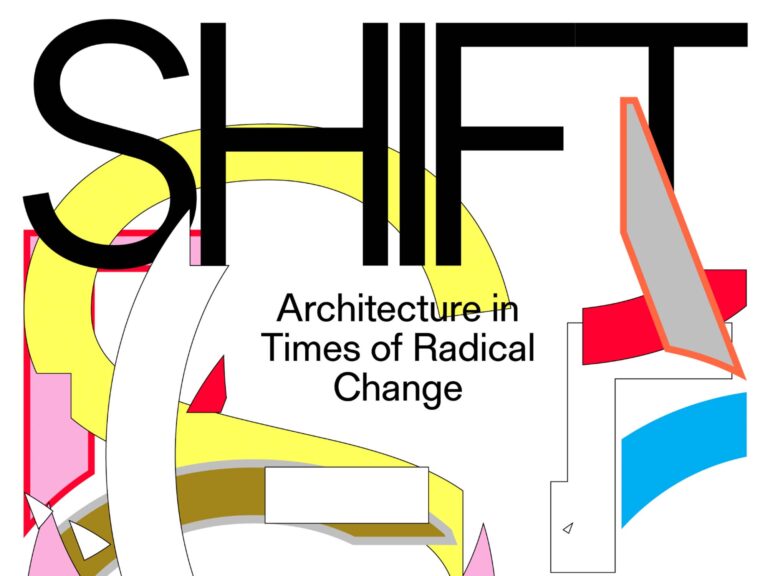By Glenn Adamson
Look across the territory of modern design, and you’ll struggle to find much in which you recognize yourself – a thing with a head and feet, that is, and all the parts in between. This ought to be surprising. After all, chairs are routinely described as having arms and legs, a back and a seat. Look further back in history than the twentieth century, and you’ll find figurative elements everywhere. True, many of these motifs are drawn from the animal kingdom: tables wrought in the shape of eagles, wings outspread; feet neatly carved with birdlike claws. But look around a bit, and you’ll also find furniture that is populated with muscled allegorical figures, and caryatids, pressed into permanent servitude as columns, and even (for a brief moment in the eighteenth century) tea tables fitted with stockings and buckled shoes.
As an imaginative adjunct to the designerly arts, figuration more or less died off in the 20th century. It’s a whodunit with an obvious perpetrator: modernism, which erupted in design with the force of revelation, just as it did in painting, sculpture and architecture. Rationalism, as it was called at the time, was as much of a head game as that name implies. Its logic was literally disembodied: the goal was to make machines for living with. That objective was every bit as extreme as the challenge that abstractionists brought to traditional painting, with an additional aggressive energy, given that designers wanted to radically transform people’s most private spaces. Human qualities did still remain in these programmatic objects. The materials of a leather-upholstered tubular steel chair, if you think about it, correlate strongly to skin, flesh and bone. But that’s the thing: you do have to think about it. In this design, human qualities are subsumed into exercises of technical research and pure form.
This orthodoxy was never as complete as our textbooks sometimes imply, of course. Outside the historical precincts of modernism, there are bodies buried here and there: the sensual Art Deco of André Groult, as in his Chiffonnier Antrophomorphe (1925); Salvador Dali’s Venus de Milo with Drawers (1936), one of many figural operations that the Surrealists performed; and still further afield, the designs of the anthroposophists, who employed figuration as a way to externalize the mental landscape.
These singular examples aside, though, there was also one moment in the 20th century when figuration came truly into vogue. This was in the late 1960s, the era of the Hippie counterculture, which viewed the body (as it viewed everything) in liberated, visionary terms. Independent makers set about applying this esprit de corps to their work, and in 1966, the Museum of Contemporary Crafts put a name to the phenomenon: Fantasy Furniture. The show included the carved wood psychedelia of Mexico’s Pedro Friedeberg, the slapstick neo-Surrealism of Tommy Simpson, and the organic designs of Wendell Castle.[1] Figuration was a perfect fit for this group for exactly the same reasons it was rejected by the modernists: it was the ideal showcase for intuitive design and skilled handwork.
The ‘60s were also, of course, the moment when Pop art and design burst on to the scene. Inasmuch as it sought to meet users (and consumers) more than halfway, it’s perhaps unsurprising that Pop’s vocabulary often included human figures in part – as in Pierre Paulin’s Tongue chair (1967) and Studio 65’s Bocce (Lips) sofa (1972), itself a nod back to Dalí – or in whole, as in the unsettling, fetishistic furniture of British artist Allen Jones. As these examples suggest, a blithe notion of sex appeal, thoroughly unacquainted with incipient feminism, was the order of the day. This was the problematic context in which Gaetano Pesce, an avatar of figurative design ever since, created his iconic Up 5 (1969), an inflatable foam chair in the shape of a voluptuous woman. He has always insisted that this was a protest against misogyny – hence its accompanying round ottoman, the Up 6, representing a ball and chain. It seems likely, however, that most observers mistakenly regarded his initial foray into figuration as simply another in Pop’s entertaining cast of characters, a reading encouraged by Pesce’s Up 7, shaped like a gigantic bare foot.
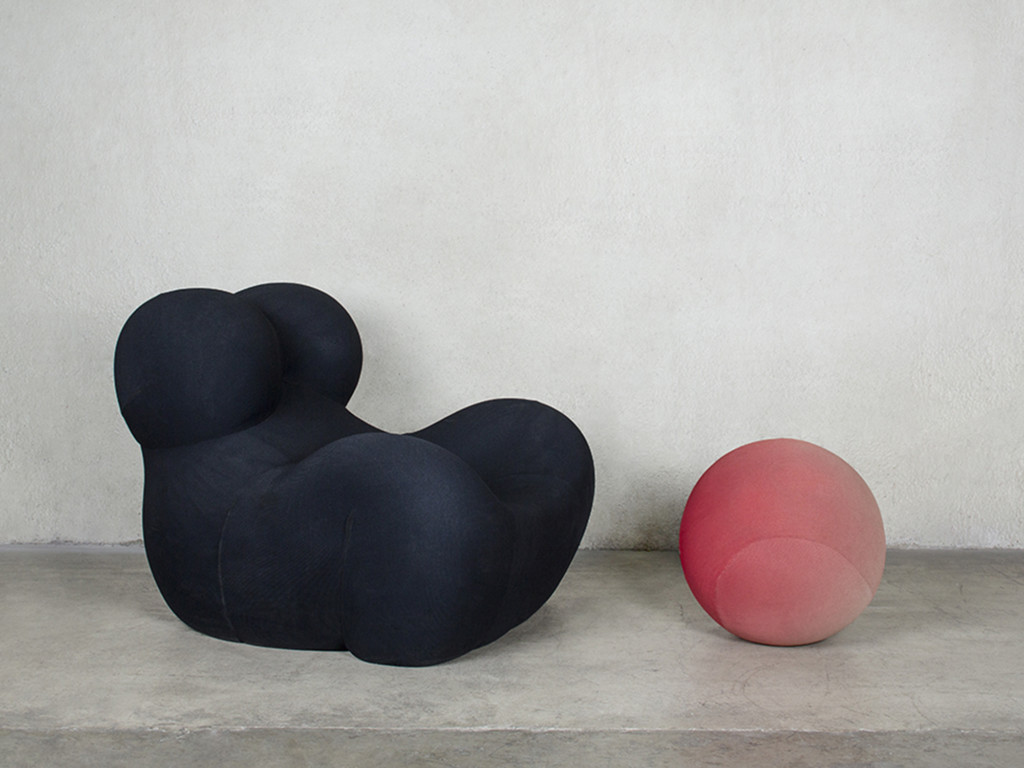
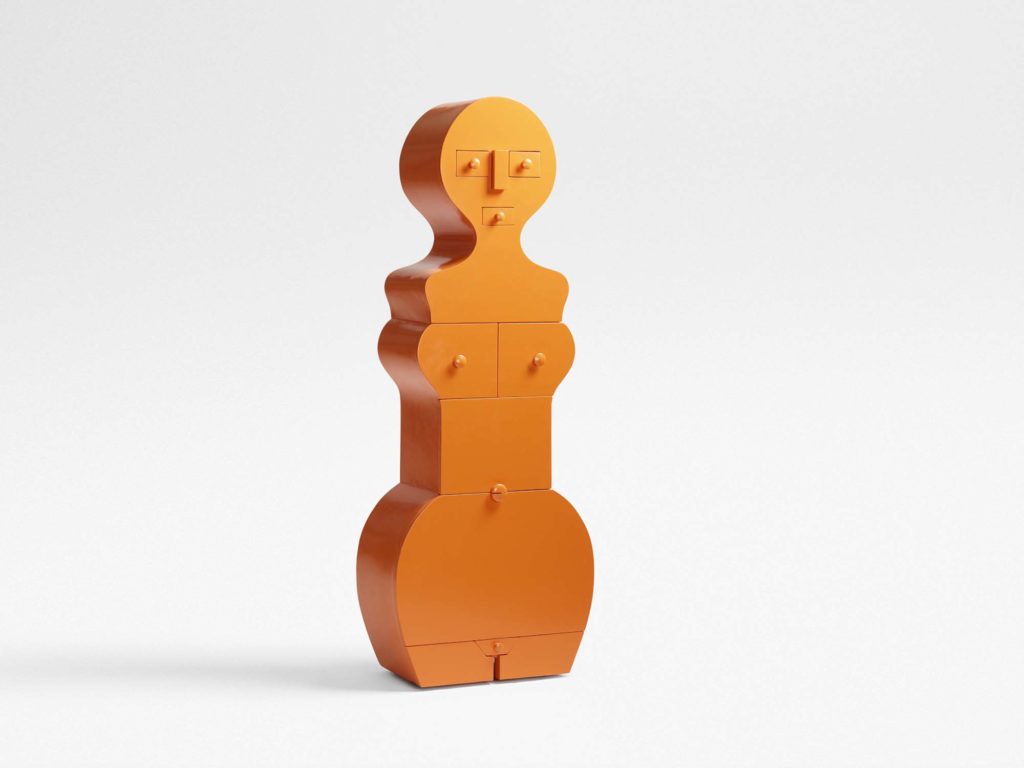
It’s also too little appreciated that, even prior to the rise of the Feminist movement in the early 1970s, women artists operating in a Pop idiom were offering an important counternarrative to what was happening in design. Another participant in the Museum of Contemporary Crafts Fantasy Furniture show was Kate Millett, soon to publish her landmark book Sexual Politics. In 1967, at an exhibition at the Judson Gallery in New York, she presented the full range of her work – absurdist yet convincingly evoking the psychological dimensions of domesticity. In this respect they bear comparison with Pop-inflected creations of her fellow New York artist Marisol, who didn’t make furniture per se but did employ the technical repertoire of cabinetmaking in her sculptures, even incorporating pieces of chairs and tables in her portrayals of seated figures. Over in France, Nicola L. created brilliant satires at the intersection of objects and objectification – in her La Femme Commode (1969), the figure’s eyes, mouth, nipples, navel and genitals are transformed into drawer pulls – while Niki de Saint Phalle, occasionally made furniture as part of her broader project of joyous self-empowerment.
As quickly as Pop came, it went, leaving questions about the relation between gender and furniture unresolved. Incredibly, a full half-century has ensued since, without sustained investigation of figuration and its possibilities. The body was central to a new area of design thinking in the 1970s, ergonomics; but that was a neo-modernist project, its dominant metaphor still that of the machine, now calibrated to operate quasi-scientifically upon the user. Postmodernism, that most permissive of design movements, could well have incorporated figurative iconography into its repertoire. But it didn’t, apart from a few tongue-in-cheek product designs by Alessandro Mendini, some of Michael Graves’ commissions for Disney, and the funny little guy hidden at the top of Ettore Sottsass’s Carlton bookcase. Overlapping trends like high-tech and creative salvage, given their emphasis on materiality, were even less apt to engage with figuration, and the same was true of the Dutch-led conceptual turn of the 1990s.
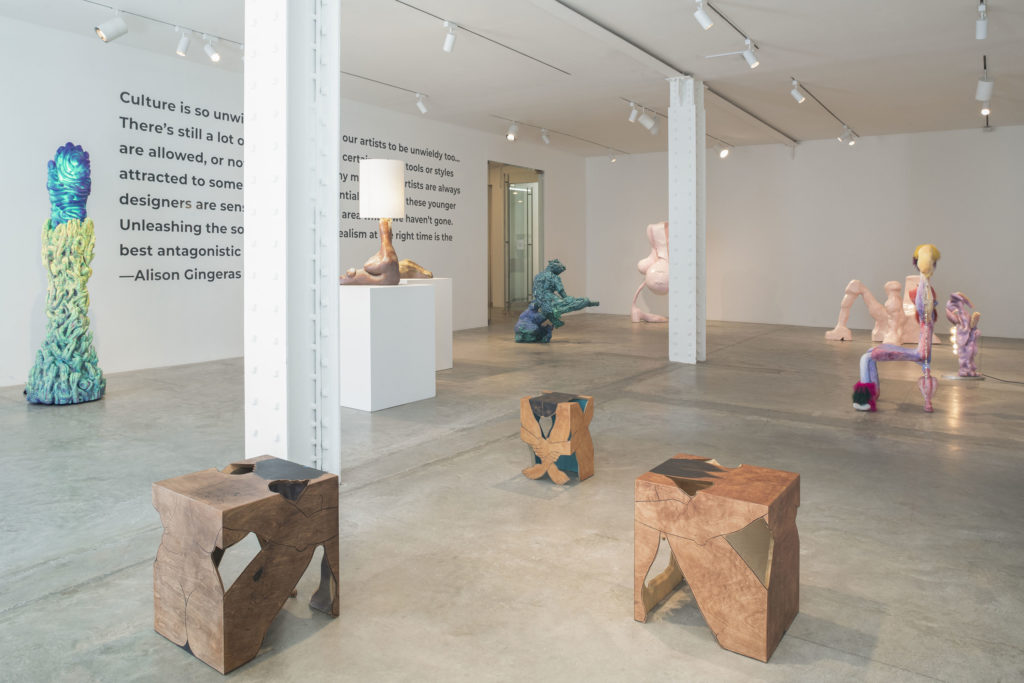
Even in the 21st century so far, a wide-open period in design history, mobilizations of organic form have tended to be more metaphorical than iconographic. This is all the more striking because the field’s technical repertoire has developing so robustly. With decades of innovation in technology and production strategy behind them, independent designers are able to make unprecedentedly complex sculptural forms and articulated surfaces. The conditions required to make ambitious figuration have been there. But it’s only very recently that designers are embracing figuration as a modus operandi. They have done so totally independently of one another; this is a zeitgeist, not a movement. The present exhibition features seven of these designers, most of them just establishing their careers. They are far-flung both geographically – from the USA to several corners of Europe to China – and aesthetically, working across a range of materials and aesthetics. Even so, their near-simultaneous arrival suggests something quite particular is going on.
So: why figuration, and why now? To begin with the obvious, we are living through a period of rampant self-representation. It’s the era of the selfie and the profile, genres now implicated in the most essential of social activities, from internet dating to gig economy employment. When cultivating such pseudo-persona, difficult questions invariably arise: How honest should I be about myself – how much should I disclose? What makes me unique, desirable, admirable? Who, in fact, am I? Faced with such posers – and outfitted with an ever-expanding arsenal of tools to explore them – we become, inexorably, poseurs, constructing shape-shifting avatars rather than literalist self-portraits.
Painters and sculptors have been working through these questions about the virtual for years, now, and one way we could understand the figural turn in design is, simply, as a response to what’s been happening more broadly in the visual arts. This is quite a complicated story, though, because the figure never had the disappearing act in these other disciplines that it did in design. It’s been more of a love/hate story, with figurative modes generally occupying a less theoretically authorized position than the linked modalities of formalism and conceptualism, with their supposedly superior rigor. Today, however, figuration is all but dominant in contemporary painting and sculpture. They have reclaimed their historic roles as vehicles for expressing subjective experience.
It’s telling that Black artists have been among the primary protagonists of this renewal – Kerry James Marshall, Tschabalala Self, Amy Sherald, Michael Armitage, Lynette Yiadom-Boakye, and Simone Leigh, to name just a few – signaling the importance of figurative painting in the expression of long-marginalized voices. No term is more politicized, nowadays, than “identity.” On the one hand, in keeping with our online representations, there’s an increasing appreciation of the self as a fluid domain, and identity as something performed rather than inherent. On the other hand, a dominant theme in cultural debate is the power (and too often, the violence) to which the racialized, gendered self is subjected. Phrases like “Black and Brown bodies” and “my body, my choice” have become incantatory refrains. These two ideas – that identity is malleable, and that it’s an impervious barrier between worldviews – aren’t necessarily in outright contradiction. But it certainly makes for a complicated picture. The body (to adapt a line from Barbara Kruger) is increasingly perceived as a battleground, where coercion and liberation contend.
The new figurative design constitutes an unusual instance of the field responding directly to prevailing trajectories in fine art. Just as in contemporary figurative painting and sculpture, design is being used to probe identity, and staging highly-charged face-to-face encounters. Yet functional objects also have their own particular dynamics. Even at the fundamental level of engineering, a designer working with figuration must negotiate questions that wouldn’t otherwise arise. Should a chair’s legs and arms actually be shaped like legs and arms, or should the mimetic relation to a body be more elastic? How best to integrate elements that do not have a figurative correlate, like doors and tabletops? Then there is the critical question of function: how a real-world body will engage with the one manifested in the object. Perhaps taking it by the hand, or even sitting in its lap?
As these potential affordances begin to suggest, figurative design also has a unique capacity to sustain narrative. The object may tell its own short story, or serve as a focal point within a larger project of imaginative world-building. It’s worth noticing that none of the works in this show is particularly naturalistic, much less hyper-realist. As in comics, movies, and video games – the visual culture on which this generation of designers was raised – the bodies are morphed, altered, hybridized. There’s a sense that anything can happen. In a curious way, this extreme creative license opens a backdoor to abstraction. Color and composition, two of the primary factors in any abstract form, are treated with total freedom in the new figurative work. Mimesis may be an animating premise, but it’s held in dialogue with purely geometric and gestural considerations. This dialectic resolves itself as stylization, another despised term in modernist design theory, here allowed to run riot. The exhibition is a pageant of theatrical sensibility, with the objects’ abstract traits expressing individuality in a manner akin to clothing, hairstyle, and personal demeanor.
This sort of personification introduces a whole new expressive realm; furniture can be comic, melancholy, and enraged. Above all, figurative design invites us to wonder who an object is meant to represent, as well as what. This marks a delayed engagement with the work of artists like Marisol and Nicola L., who seem premonitory in retrospect. What they were exploring a half-century ago returns now in design, in a fiercely updated fashion. Several of the artists here render the female-coded body in uncompromisingly subjective fashion, a thunderous clapback against stereotype. Given that the field of professional design is still nowhere near gender parity, the collective feminist force of these works may well be the most significant aspect of the new figuration.
Another way to think about the potency of these objects is to consider their totemic quality. Again, this is a tendency that appears in contemporary sculpture (think of Huma Bhabha, for example), but it has special resonance in design because of the object’s implied insertion into everyday life. The totem can be understood, in this context, as a symbolic artifact in which social and spiritual energies are compressed. It’s a means by which a community represents itself, to itself. The most ancient of sculptural types, it also feels urgent – even futuristic – in that it offers a potential bridge between the subjective and the universal. I’ve noted several times, in this essay, the emphasis on individualism that informs the current figurative impulse. It’s also clear, however, that we need to find alternatives to that intense first-person perspective. Taken to extremes – the atomization and alienation that we see everywhere nowadays, both online and off – it threatens to tear the social fabric, producing various configurations of us vs. them. We badly need things to believe in, together.
This is a lot to expect from our furniture. But as we’ve seen, figurative design is not happening in isolation. It is one current in a gathering wave, which is sweeping aside long-stable hierarchies of value. That sounds portentous, and the new figuration is certainly not asking anyone’s permission. Having crashed the well-kept gates, though, the energy it’s bringing is overwhelmingly positive. As we have worked toward this exhibition, seeing the work in progress – all these objects coming gradually to life – it’s been possible to discern the project’s contours. What it looks like, more than anything, is a party starting. And this time, everyone is invited.
[1] Tommy Simpson subsequently published a book expanding on the exhibition, Fantasy Furniture: Design and Decoration (New York: Reinhold, 1968). Castle’s work of this period was only implicitly figural, but he would pursue the mode in his later trompe l’oeil carvings.
This essay was originally published in exhibition catalogue The New Figuration, Friedman Benda, New York, NY, March 2022.
